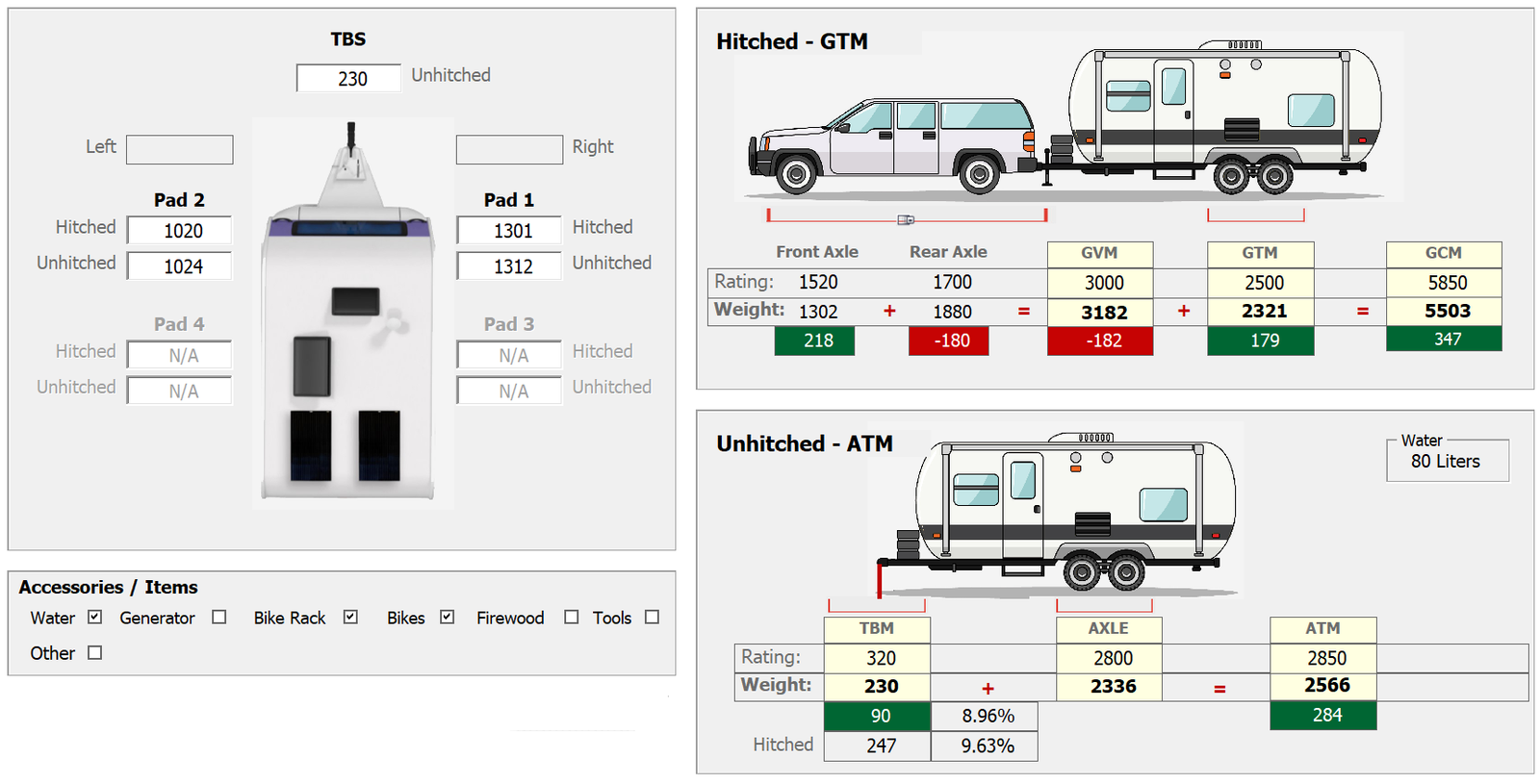

Understanding how a vehicle and caravan are weighed, can be confusing. Especially with all the acronyms and terminology. The following document explains the process we follow when onsite and why we do each step. It is important to note, that we explain each step as we go and answer any questions you have.
Our goal is to not only give you a detailed report, outlining all your weights and recommendations, but to also give you complete peace of mind. Ask questions! There is no such thing as a stupid question.
We have developed a comprehensive software and reporting solution, so we can visually show you the weights and terminology as we weigh your setup.
Please make sure your Caravan is hitched to the Vehicle and on flat, level ground, such as concrete or asphalt. Grass, gravel, and soft ground is not suitable for weighing as the weights recorded will not be accurate.
Ideally, you will have your van loaded as you would normally travel, with your water tanks full.
The weighing process takes approx. 90 minutes depending on your setup. If adjustments are required, the process may take longer.




When we arrive onsite, we will check the VIN Plate on the Vehicle and Caravan/Trailer to record the weight specifications and ratings. We will explain the numbers and show you the payload for the caravan.
Once all our equipment is setup and in place, we weigh your vehicle and caravan as follows:
The following metrics are recorded and explained when weighing the vehicle.
1. Weigh the Vehicle while hitched to the caravan
Portable Weighing Pad / Scale is placed in front of each wheel of the car. We then ask you to drive onto the pads.
This will record the Front Axle Weight, Rear Axle Weight which then adds up to the total vehicle weight. At this stage, it includes the Tow Ball Mass from the Caravan.
The total vehicle weight is recorded and measured against the Gross Vehicle Mass (GVM) rating for your vehicle.
2. Weigh the Vehicle while unhitched from the caravan.
At this stage the vehicle is left on the weighing pads, and we unhitch the Caravan/Trailer from the vehicle. We simply use the jockey wheel to get the weight off the Tow Ball.
This is important as it allows us to measure the different axle loadings and see what impact the tow ball mass has on the way the vehicle will handle. For example, if the front axle is too light, you can suffer understeering and break burnout.
2a. Weight Distribution Hitches (when in use)
The caravan is hitched up to the vehicle again while it is still on the portable weighing pads. The Weight Distribution Hitches (WDH’s) are connected and set to their usual tension. We now have all the information necessary to compare the axle loadings and to make sure the WDH’s are applying the correct weight back to the front axle. This ensures the WDH’s are tensioned correctly and operating effectively. Adjustments to the WDH are made as required.

Now that the vehicle weighing is complete, we now move onto the caravan/trailer. The goal of this process is to record and explain the following metrics.
The following metrics are recorded and explained when weighing the vehicle.
1. Weigh the Caravan while hitched to the Vehicle
The Portable Weighing Pads / Scales are placed in front of each wheel of the Caravan. We then ask you to drive onto the pads.
This will record the Axle Weight of the Caravan. For dual axle caravans we record each axle weight to check the balance of the caravan. This gives us the Axle Load which is then measured against your Gross Trailer Mass (GTM). This is the GTM as the Tow Ball Mass is recorded as part of the vehicles weight.
2. Weigh the Caravan unhitched from the Vehicle
While the caravan is on the weighing pads, we unhitch from the vehicle and move the vehicle forward. This allows us to level the caravan and record the Tow Ball Mass, using our Tow Ball Scale. We also measure the height of the coupling and compare this to your Tow Ball height, to ensure the Caravan is sitting slightly nose down when towing.
This gives us the “all up weight” of the caravan which is then measured against your Aggregate Trailer Mass (ATM). This is the ATM as it includes the Tow Ball Mass.
